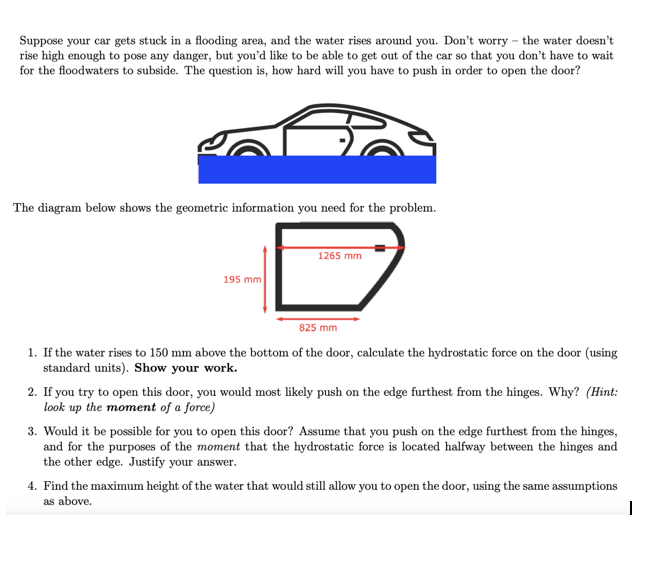Suppose your car gets stuck in a flooding area, and the water rises around you. Don't worry – the water doesn't rise high enough to pose any danger, but you'd like to be able to get out of the car so that you don't have to wait for the floodwaters to subside. The question is, how hard will you have to push in order to open the door? The diagram below shows the geometric information you need for the problem. 1265 mm 195 mm 825 mm 1. If the water rises to 150 mm above the bottom of the door, calculate the hydrostatic force on the door (using standard units). Show your work. 2. If you try to open this door, you would most likely push on the edge furthest from the hinges. Why? (Hint: look up the moment of a force) 3. Would it be possible for you to open this door? Assume that you push on the edge furthest from the hinges, and for the purposes of the moment that the hydrostatic force is located halfway between the hinges and the other edge. Justify your answer. 4. Find the maximum height of the water that would still allow you to open the door, using the same assumptions as above.
Suppose your car gets stuck in a flooding area, and the water rises around you. Don't worry – the water doesn't rise high enough to pose any danger, but you'd like to be able to get out of the car so that you don't have to wait for the floodwaters to subside. The question is, how hard will you have to push in order to open the door? The diagram below shows the geometric information you need for the problem. 1265 mm 195 mm 825 mm 1. If the water rises to 150 mm above the bottom of the door, calculate the hydrostatic force on the door (using standard units). Show your work. 2. If you try to open this door, you would most likely push on the edge furthest from the hinges. Why? (Hint: look up the moment of a force) 3. Would it be possible for you to open this door? Assume that you push on the edge furthest from the hinges, and for the purposes of the moment that the hydrostatic force is located halfway between the hinges and the other edge. Justify your answer. 4. Find the maximum height of the water that would still allow you to open the door, using the same assumptions as above.
Elements Of Electromagnetics
7th Edition
ISBN:9780190698614
Author:Sadiku, Matthew N. O.
Publisher:Sadiku, Matthew N. O.
ChapterMA: Math Assessment
Section: Chapter Questions
Problem 1.1MA
Related questions
Question
100%
only 3 and 4

Transcribed Image Text:Suppose your car gets stuck in a flooding area, and the water rises around you. Don't worry – the water doesn't
rise high enough to pose any danger, but you'd like to be able to get out of the car so that you don't have to wait
for the floodwaters to subside. The question is, how hard will you have to push in order to open the door?
The diagram below shows the geometric information you need for the problem.
1265 mm
195 mm
825 mm
1. If the water rises to 150 mm above the bottom of the door, calculate the hydrostatic force on the door (using
standard units). Show your work.
2. If you try to open this door, you would most likely push on the edge furthest from the hinges. Why? (Hint:
look up the moment of a force)
3. Would it be possible for you to open this door? Assume that you push on the edge furthest from the hinges,
and for the purposes of the moment that the hydrostatic force is located halfway between the hinges and
the other edge. Justify your answer.
4. Find the maximum height of the water that would still allow you to open the door, using the same assumptions
as above.
Expert Solution
This question has been solved!
Explore an expertly crafted, step-by-step solution for a thorough understanding of key concepts.
This is a popular solution!
Trending now
This is a popular solution!
Step by step
Solved in 4 steps with 12 images

Knowledge Booster
Learn more about
Need a deep-dive on the concept behind this application? Look no further. Learn more about this topic, mechanical-engineering and related others by exploring similar questions and additional content below.Recommended textbooks for you

Elements Of Electromagnetics
Mechanical Engineering
ISBN:
9780190698614
Author:
Sadiku, Matthew N. O.
Publisher:
Oxford University Press

Mechanics of Materials (10th Edition)
Mechanical Engineering
ISBN:
9780134319650
Author:
Russell C. Hibbeler
Publisher:
PEARSON

Thermodynamics: An Engineering Approach
Mechanical Engineering
ISBN:
9781259822674
Author:
Yunus A. Cengel Dr., Michael A. Boles
Publisher:
McGraw-Hill Education

Elements Of Electromagnetics
Mechanical Engineering
ISBN:
9780190698614
Author:
Sadiku, Matthew N. O.
Publisher:
Oxford University Press

Mechanics of Materials (10th Edition)
Mechanical Engineering
ISBN:
9780134319650
Author:
Russell C. Hibbeler
Publisher:
PEARSON

Thermodynamics: An Engineering Approach
Mechanical Engineering
ISBN:
9781259822674
Author:
Yunus A. Cengel Dr., Michael A. Boles
Publisher:
McGraw-Hill Education

Control Systems Engineering
Mechanical Engineering
ISBN:
9781118170519
Author:
Norman S. Nise
Publisher:
WILEY

Mechanics of Materials (MindTap Course List)
Mechanical Engineering
ISBN:
9781337093347
Author:
Barry J. Goodno, James M. Gere
Publisher:
Cengage Learning

Engineering Mechanics: Statics
Mechanical Engineering
ISBN:
9781118807330
Author:
James L. Meriam, L. G. Kraige, J. N. Bolton
Publisher:
WILEY